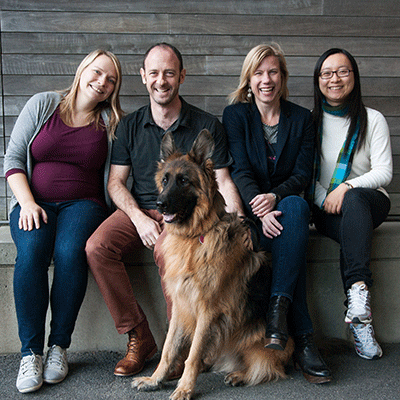(l to r) Kat Toropova, Andres Leschziner,Sam Reck-Peterson, Sirui Zou and (front row) Locksley
Cytoskeletal motors are molecular machines that “walk” along the filaments that provide structural support and a transit network to eukaryotic cells. The three types of motors are myosins, kinesins and dynein, and they walk along the two main types of filaments: actin filaments (myosins) and microtubules (kinesins and dynein). All cytoskeletal motors walk along their tracks by coupling a cycle of ATP hydrolysis and a cycle of track binding and release, with specific nucleotide states of the motor corresponding to either low or high affinity for their filament.
A major feature of cytoskeletal filaments is their polarity, which allows motors to move unidirectionally. In the case of microtubules, this has led to a specialization, with most kinesins moving towards the “plus” (rapidly growing) end of microtubules and dynein moving in the opposite direction (the “minus” end). Thus, kinesins typically transport cargo towards the periphery of the cell and dynein brings it in from the periphery towards the center. While the polarity of the cytoskeleton facilitates the organization of intracellular transport, it also poses an interesting conundrum for the motors: How do motors get to the start of their track? How do they wait there to be loaded with cargo, given their intrinsic propensity to walk back?
In collaboration with the group of Samara Reck-Peterson (Department of Cell Biology, Harvard Medical School), we have been working on answering the second question. We previously showed that Lis1, a protein identified as the site of mutations in the rare but severe neurodevelopmental disease lissencephaly, had the functional properties necessary to stall dynein on microtubules: when bound to Lis1, dynein keeps going through the ATP hydrolysis cycle that normally powers the motor yet, rather than walking, it remains tightly bound to its track [Huang, Roberts et al. (2012), Cell]. We proposed at the time that Lis1 was working as a “clutch”, uncoupling dynein’s engine (the ATP hydrolysis cycle) from its wheels (the cycle of microtubule binding and release). However, while we understood what Lis1 was doing, we did not understand how it was doing it.
In a paper recently published in eLIFE [Toropova, Zou et al. (2014), eLIFE], our two groups used a combination of structural biology, biochemistry, single-molecule and in vivo assays to understand the molecular basis of Lis1’s regulation of dynein. The team included three postdoctoral fellows—Kat Toropova, Anthony Roberts and Bret Redwine—and two graduate students—Sirui Zou and Brian Goodman. We began by obtaining the structure of the dynein-Lis1 complex using cryo-electron microscopy. The structure revealed that Lis1 bound to dynein’s AAA+ “ring” (the motor domain where ATP hydrolysis takes place), right next to where dynein’s microtubule-binding domain (the motor’s “leg”) emerges from the ring. Intriguingly, the presence of Lis1 appeared to physically block the movement of dynein’s main mechanical element, the “linker”. This element is a lever-like domain that swings across the ring in a nucleotide state-dependent manner and is responsible for dynein’s force generation. In addition to participating in generating force, the linker makes important contacts with dynein’s ring that are required for coupling the nucleotide state of the motor with the affinity between dynein’s “foot” (the microtubule-binding domain) and its track.
Using Förster Resonance Energy Transfer (FRET) we showed that the linker was free to move in response to the nucleotide state on one side of the block imposed by Lis1. To test the idea that the linker’s inability to move past Lis1 in the other direction was responsible for keeping dynein stalled on microtubules, we shortened the linker to a point where it would be able to physically bypass Lis1’s block. While a dynein carrying this short linker behaved similarly to the wild type motor, it was no longer regulated by Lis1 and, instead, it behaved as though the regulator were no longer present. How Lis1 manages to keep the ATP hydrolysis cycle going while dynein is not moving remains a mystery that we will address in our future work.




